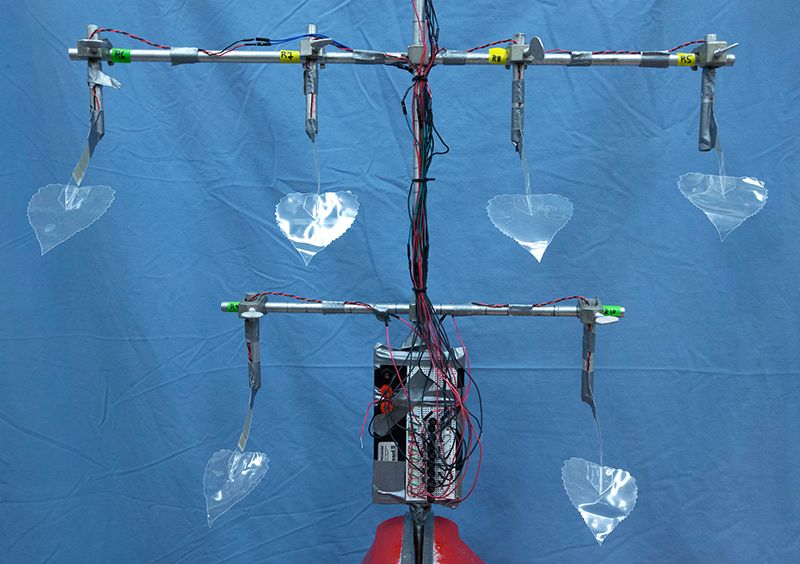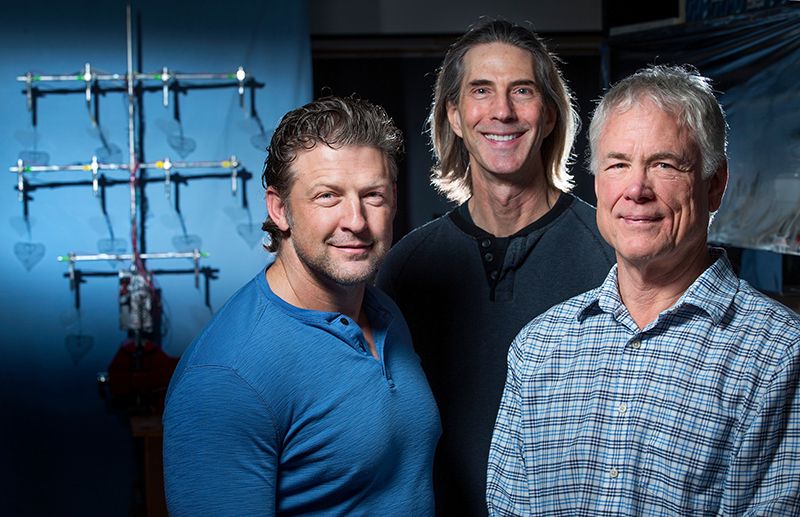Are Artificial Trees the Future of Renewable Energy?
While a new device’s flapping leaves can generate a lot of energy, extracting it is far from a breeze
/https://tf-cmsv2-smithsonianmag-media.s3.amazonaws.com/filer/32/82/32823446-1c6d-40e4-82f4-9643ce61cdbe/cottonwood.jpg)
In 2007, Eric Henderson watched the heart-shaped leaves of a redbud rustle in the wind outside of his home in Iowa. A gust came through, whipping around the tree’s branches, causing the leaves to oscillate in the turbulent stream of air.
“And that got me thinking,” he says.
Henderson, a molecular biologist at Iowa State University, started toying with the idea of harvesting these random gusts. “It’s not wind that will ever see a turbine because it’s low to the ground and it’s going through little eddies and swirls,” he says. But there is still energy there.
This started him on an obsession with leaves—studying their shapes, aerodynamics, oscillations at the slightest provocation. He recruited two other researchers from the university, Curtis Mosher and Michael McCloskey, to help him, and together, the concept of the faux forest blossomed. The idea was that by creating leaves out of certain materials, they could harvest the energy from the bending leafstalks.
Everything hinged on a method known as piezoelectrics, which has been around for over a century. Discovered by Jacques and Pierre Curie in 1880, they have been used in a variety of gadgets—from early phonographs (where piezoelectrics turned the vibrations from the needle into electric current) to spark lighters.
The concept is based on manipulation of materials that have a regular array of covalent bonds, a chemical connection in which two atoms share electrons. “In a crystal, all those [bonds] are in a very ordered state,” says Henderson. “If you squeeze it, or push it, or tweak it, it shifts.” And if manipulated properly, this shuttling back and forth of electrons can generate electricity.
The basics of the researchers’ idea was simple: build a tree-shaped electricity generator with plastic leaves that have stalks made out of polyvinylidene fluoride (PVDF), a type of piezoelectric plastic. Plunk the tree outside in any region with a breeze and harvest the energy as the fake leaves sway to and fro.
But, as they recently published in the Journal PLOS ONE, the situation is much more complicated. “It all sounds great until you try to do the physics,” Henderson says.

First trouble is the conditions necessary for actually generating electricity, explains McCloskey, who is also an author on the paper. Though the leaves flap in the wind, supposedly generating electricity, the only way to get useful energy is from high frequency, regularly spaced bending of the stalks—a condition rarely found in nature.
It also turns out that the amount of energy produced may be related to how quickly the stalks are bent. When they set a fan up so its blades could actually strike the leaf as it spins, they were able to light an LED. But again, this is not a situation common in nature.
There’s also something known as parasitic capacitance, he explains. Like its namesake, this phenomenon is akin to a leech sucking the lifeforce out of a hapless creature. Though the wind can supposedly generate a lot of energy as the leaves oscillate, various parasitic effects—like the leaf wiggling in multiple directions—steal sips of that energy, effectively canceling out the electrical charges. And in the end, barely anything remains.
To top it off, collecting those remnants of energy is far from a breeze. Due to the nature of the materials, energy is lost during transfer to a battery. And though they could charge a small battery, McCloskey says it would take “a glacial age.”

As the team tirelessly worked to compensate for these problems, they started to see others chasing down the same idea. And though some attempts are better than others, there seems to be a lot of hot air in terms of what people are claiming to be able to do with this tech, according to Henderson and McCloskey.
There are even companies claiming to be able to actually harness this energy. One, called SolarBotanic, hopes to marry an ambitious combination of energy technologies on each leaf of their fake tree: solar power (photovoltaics), heat power (thermoelectrics), and piezoelectrics. The problem, explains McCloskey, is that in comparison to solar energy, piezoelectrics produce a miniscule amount of energy. The company was founded in 2008. Nine years later, the faux forest has yet to materialize.
Last year, Maanasa Mendu won the 2016 Young Scientist Challenge with a similar iteration of a faux, energy-producing tree. But she, too, acknowledged the limitations of piezoelectrics, incorporating flexible solar cells into the device.
“I don't think it's a bad concept to have a [fake] plant or even a real plant that's modified,” says McCloskey. “It's just this particular scheme of piezoelectricity—I don't think it's going to work with current materials.”
The team, however, is also working on another angle: synthesizing a material that mimics a protein found in the human ear that is crucial for amplifying sound. Though the details they could give about the project are limited due to pending invention disclosures, McCloskey can say the material has a piezoelectric efficiency 100,000 times greater than their current system.
By ruling out current methods of piezoelectrics, the team is one step along the path to figuring out the best way to tackle the trees. As Edison purportedly said while struggling to develop a storage battery: “I have not failed. I have just found 10,000 ways that won’t work.”
McCloskey adds: “This is one of those 10,000.”
/https://tf-cmsv2-smithsonianmag-media.s3.amazonaws.com/accounts/headshot/Wei-Haas_Maya_Headshot-v2.png)
/https://tf-cmsv2-smithsonianmag-media.s3.amazonaws.com/accounts/headshot/Wei-Haas_Maya_Headshot-v2.png)